Report by Annapurna Barry
On Tuesday 16th May 2017 MA Contemporary Literature and Culture students organised a pioneering and interactive event, The Contemporary: an Exhibition, that pulled in crowds of students, prospective students, tutors and family and friends. Our exhibiters, Hope Dinsey, Daniel Pateman and Aefifa Razzaq, created intelligent and thought-provoking creative pieces that explored the idea of the contemporary and what it means to us in our current social and political landscape.
Daniel Pateman’s multimedia exhibition, Ghosts of the Future: Ruinations and Re(creation), created a discourse around the idea of our constant need for regeneration. As Daniel writes in an accompanying text, ‘there is a sense in our culture today of a desire for social, personal and political renewal; of myriad possibilities for change rather than the perceived inevitabilities of monolithic systems.’ Although Daniel’s photographs could initially be seen as an investigation into the hopelessness of contemporary life, they are instead aiming to be hopeful and to suggest that contemporary life is in a perpetual state of transformation and that ruinations are symbols of regeneration and in fact sites of recreation. The photographs in Ghosts of the Future feature a range of sites that are decayed and/or abandoned such as disused hospitals, graveyards and factories. I spoke to Daniel and our guests and everyone seemed to be in agreement that even though these sites remind us of mortality and echo Gothic ideas of the sublime, they are in fact a positive portrayal of the contemporary and of the now – society is moving towards a less binary view of the world and of life and death, and towards a mentality that sees beauty and hope in destruction. Daniel’s exhibition also featured poems ‘I am Demetrius’ and ‘I am Lazarus’ on black card, which metamorphosise and degenerate into a structure-free form that gives the poems opportunity for renewal and leaves them open to interpretation – an exciting development in contemporary aesthetics.
Daniel Pateman’s Ghosts of the Future: Ruinations and Re(creation)
This idea of text and narrative being an unstable and unfixed concept, as seen in Daniel’s poems, is something that Hope Dinsey’s exhibit, The Expansion of Narrative in the Digital Age, explores. When I chatted to Hope about her work, she spoke of how since the advent of the internet methods of storytelling and traditional narratives found in literature, film and art have developed and morphed into something entirely new. Hope’s detailed exhibition explored avenues such as fandom, hypertext, fantext and interactive gaming, none of which possess a set narrative. We arguably live in a society that is characterised by choice and it seems that this desire has fuelled the digital age: people want to make their own stories and create individual meanings for those stories. The Expansion of Narrative in the Digital Age pinpoints fandom’s rise to popularity in the 1990s as something that reached a widespread global audience, enabled by the internet. Hope’s work explains how fandom is in a constant state of creation as, in her words, ‘media does not exist in a bubble’ and fans are continuously contributing to this wider dialogue, each contribution distinctly individual to the contributor. These contributors are representing their personal views and ideologies, ones which do not necessarily correlate with the author’s original intentions. Talking to people throughout the evening, Harry Potter seemed to be the most talked about franchise – J.K. Rowling’s novels have morphed into Pottermore, fan fiction, Harry Potter World and a theatre production, just to name a few! The magical world that J.K. Rowling created seems to be only the beginning of the narrative, proving that fan interaction and fandom not only keep a story alive but help to create perhaps more diverse narratives. Hope’s exhibition perfectly captured how enormously important the notion of digitalisation is in the contemporary age. The Expansion of Narrative in the Digital Age featured books that disrupt traditional ideas of narrative, such as Doug Dorst and J.J. Abrams’s S and Mark Z. Danielewski’s House of Leaves. Hope spoke enthusiastically about Chuck Palahniuk’s Invisible Monsters (Remix), which was actually originally published in a traditional narrative form but later in a remix version. Interestingly this was Palahniuk’s preference, suggesting that it is not only readers who are interested in creating their own meaning. The remix version demands that readers flick through the book, both backwards and forwards, and read the novel out of order, which destroys traditional concepts of narrative and empowers the reader as they ultimately have control of the novel. Certainly, the contemporary seems to be about destroying the so-called normal ways in which we interact with texts and take meaning from them, as we can see from the interactive story that Hope created.
Hope Dinsey’s story 'Twisted Paths' can be read here.
Aefifa Razzaq’s exhibition, It’s a Fairy Tale, provided us with an interesting insight into how children engage with politics and interpret political language. Aefifa and her pupils' work concentrated on the unstable American political landscape, one that is very much in the international public eye since the election of Donald Trump. Society is questioning the idea of life being a fairy tale with a happy ending but more importantly it is questioning whether a villain can really be a hero. What is really interesting is that the pupils, aged 9-13, were aware of Donald Trump and his politics, which suggests that the contemporary world we are living in, with its widespread use of internet and social media, is allowing young people to become increasingly informed. Aefifa’s pupils created a wonderfully rich sketchbook which contrasts previous US Presidents’ language and rhetoric with images of Donald Trump and his associates, such as Vladimir Putin. One page quotes President Kennedy: ‘this nation was founded by men of many nations and backgrounds. It was founded on the principle that all men are created equal, that the rights of every man are diminished when the rights of one man are diminished’. This is an idea which is certainly not supported by Trump who has vowed to build a wall to keep Mexicans out of America as well as trying to enforce a travel ban on Muslim people (and that is by no means an extensive list!). Aefifa displayed pupils’ opinions on Trump’s language and persona, and visitors to the exhibition found these observations a fascinating insight into Trump as a powerful public figure. One contributor wrote that our society ‘places more value in an empty slogan than a statement with substance. “Make America Great Again!”’, which suggests that perhaps Trump has been allowed to flourish because the idea of what a President should be is changing – is contemporary society more interested in empty rhetoric and performance, rather than a president like Obama or Kennedy? Another contributor wrote, ‘I don’t find Trump’s language inspiring because he doesn’t seem informed and appears old-fashioned and out of date with current thinking’, which is certainly an idea that is in keeping with liberal thinking. Those attending the exhibition certainly had strong views on Trump, with one woman saying he was a puppet whose every move and word is controlled. Indeed, many agreed that Trump seems more like an entertainer than a politician. Politics is certainly changing, showing that the contemporary is a notion characterised by uncertainty and instability.
Aefifa Razzaq’s It’s a Fairy Tale
The exhibition also included a small collection of MA Contemporary Literature and Culture students’ videos, which demonstrated their personal views of the contemporary. This was an opportunity to engage in discussion with our attendees about how our course has shaped our views of globalisation, technology, literature and postmodernism but also about our own individual interpretations of the contemporary. Another attraction at the exhibition was the virtual headset that people were encouraged to try out and it proved very popular! The virtual reality game was Ahmed Malik’s VR Jet Fighter F-16 Real Pilot Dogfight Simulation which allows players to experience virtual reality as a pilot in a fighter jet but the existence of virtual reality forces us to question how war is used as entertainment in contemporary society. It is also important to note that virtual reality is used by the military for training, which perhaps questions how we engage with war but is also an indication of how entertainment and the desire for experience shapes the contemporary.
The exhibition was a great success that allowed students to express themselves and engage with a range of ideas related to the contemporary. It is clear that the contemporary is a sprawling, wild concept that is open to personal interpretation, much like the decomposed poems, political language and interactive fan texts that were exhibited. I would like to say thank you to our talented exhibitors, our wonderful hosts (Magdalena Salata and Hafsa Alkhudairi) who gave all of our guests a warm welcome and our room organiser (Victoria Ogunsanya). On behalf of everyone, I would like to say thank you to Dr Grace Halden for all of her wonderful guidance and encouragement and of course a huge thank you to The Arts Week Committee who generously funded our exhibition and made it all possible!
Annapurna Barry stands with the class exhibit of contemporary videos
Report by Sara Alouani
The Contemporary: An Exhibition, held as part of Birkbeck’s annual Arts Week, was hosted at 43 Gordon Square and saw Daniel Pateman, Aefifa Razzaq and Hope Dinsey exhibiting their own personal work deriving from their passion and creativity for all things contemporary. Through a combination of art, politics, digital media and creative writing, they explored innovate responses to the contemporary era.
Let’s have a closer look and explore the many ways three students of the MA Contemporary Literature and Culture have interacted with art, film, and artefacts. Here is the event as I experienced it on the day…
Entering Room G03 two posters feature a startling montage of President Donald Trump’s most famous grimaces. The posters are set on a table where a flag of the United States is hanging along with a poster bearing the first verse of ‘The Star-Spangled Banner’: ‘Oh, say can you see …’. Aefifa Razzaq’s exhibit goes far beyond the mere representation of America’s iconic President. In fact, her work aims to represent responses from primary and secondary schools. As part of the project, school children shared their thoughts on the President by writing handwritten notes that were presented on the exhibit poster. Aefifa explains the rationale behind this approach, stressing that it is important to involve children in politics and take into account their view of the world; adults should reassure children that ‘There are and there have been inspirational political leaders’ and that ‘the human race is capable of producing more than the Trump Presidency’. Reading through the small notes it is evident that the children’s answer to the question of whether Trump is an inspirational figure is unanimously negative. It becomes also apparent that Trump is viewed as isolated from the impressive line of former presidents. He is an anomaly: a blip. Nowhere is this more explicitly highlighted than in a book hand-made by Aefifa’s pupils which represents, through drawings and quotes, the chronological succession from Lincoln to Trump in which Trump is decidedly ‘other’.
Sound booms through the room; uncanny noises rather than music pulse from the large screen at the far end. The footage playing is part of Daniel Pateman’s exhibition on ruination and recreation. As a poet and a strong believer in the power of language and visual media as a way to express different meanings, Daniel represents his abstract conception of eternal change in our contemporary age through film, photography and poetry. On a board, Daniel creates a patchwork of pictures and poems written by him, which represent the varied possibilities of life coming from, and challenged by, ruination. Daniel’s fascination with ruins comes from an alternative and positive vision of destruction as a source of hopeful reconstruction, which becomes an essential part of life as progress. The different representation of Daniel’s two poems ‘I am Detritus’ and ‘I am Lazarus’ are particularly emblematic and clarify the intense concept of recreation. Daniel explains the representation of consumed and burnt paper, which contains verses symbolizing time passing and the evidence of change. The bacteria that have settled on the piece of decomposed paper creating small green stains represent the course of life and underline life’s eternal continuum. Daniel highlights the importance of the meaning of these bacteria, which are a true representation of life starting from the ruination process.
Hope Dinsey’s exhibit is arranged over two tables and I cannot help but notice a selection of contemporary fiction covering the surface punctuated with iPads. The traditional paper books contrast with the most recent devices and thus summarize in a square metre the evolution of narrative and storytelling. Hope is passionate about experimental literature and does not lose the chance to draw my attention to the site ink-splotch on TumbIr, with a text answering the question: ‘Hey would you ever do a "what if harry potter had been a girl" story? or a trans girl?’ This remake, belonging to the category of fandom literature, demonstrates an increasing popular way of distorting well-known stories by simply changing one of the details. For instance, in this case the blogger ink-splotch rewrites J.K. Rowling’s bestseller modifying Harry Potter’s sexual identity. Hope explains that fandom is an evergreen style of storytelling that allows writers to experiment employing creativity as lowest common denominator. Many of them feature same sex couples or, as the blogger ink-splotch demonstrates, they simply rebuild a well-known story with a ‘what-if’ plot. Hope dedicates part of her exhibition to the rising category of interactive literature and gaming, which has been in the spotlight for the last decade. Hope’s creative spirit along with her passion for fandom led her to write her own Hyperlink Story. It is a work that, at first sight, seems to be made up of several separate, unconnected, and unrelated storylines. It is only throughout the reading of the whole work that the audience realizes that it was all one big story all along.
Art is a powerful medium of communication and representation of the self. Art is the finest result of anyone’s creativity and its impact can be so meaningful that it can change anyone’s perspective and contribute to a better understanding of our surroundings. As the Ukranian philanthropist Victor Pinchuk has stated: ‘Art, freedom and creativity will change society faster than politics’.

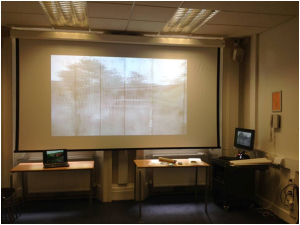
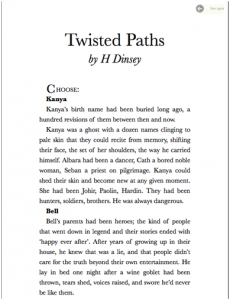
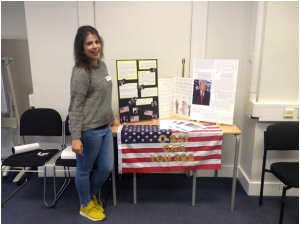
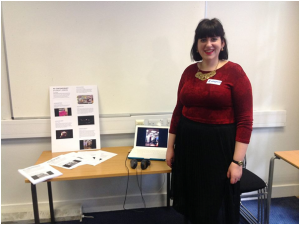
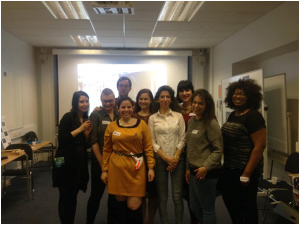
Recent Comments